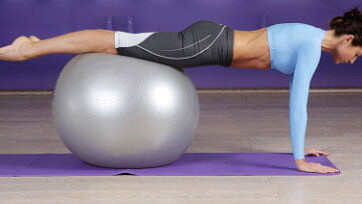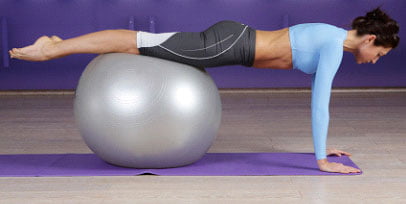
Core Stability is a bit of a buzz term, and is used very commonly not only in a physiotherapy setting, but also with gyms, personal trainers, and many other people in the fitness and rehabilitation industry. Despite its common use, the true meaning of the term “Core Stability” is really not very well understood, and more importantly, the implementation of many core stability programs is not technically correct.
What is Core Stability?
Core Stability is the term given to the retraining of the corset of muscles that surround the lower back, abdominal region, and pelvis (or core area). These muscles provide a foundation upon which other stronger muscles can act to provide us with force, power and movement.
 The best way to think of the core muscles is to imagine them like a deep enclosed cylinder of muscles in the lower abdominal region. There are four main muscle groups to consider as part of the core system:
The best way to think of the core muscles is to imagine them like a deep enclosed cylinder of muscles in the lower abdominal region. There are four main muscle groups to consider as part of the core system:
Transversus Abdominus– this is the muscle that seems to get the most attention. It provides most of the bulk of the “cylinder” and runs transversely (hence its name) from the lower back vertebra right around to the abdominal region at the front. When it contracts, it increases the pressure within the abdominal region and gives direct muscular stability to the spine.
Multifidus – these deep muscles are situated in the small of the back and when contracted assist Transversus in providing postural support and stability to the spine.
Pelvic Floor– this forms the bottom, or floor, of the cylinder and is commonly mentioned during and after pregnancy. However (often to their surprise) men have a pelvic floor too that is just as important as a woman’s. It provides support to the internal pelvic organs and works closely with Transversus to provide pelvic stability.
The Diaphragm – this is possibly the most neglected of the core muscles, as there is no exercise for it in the gym. However the diaphragm forms a critical component of the core as it provides stability at the top of the muscular cylinder – without it, all the pressure and support developed would be lost out the top end of the cylinder. This is why in many good stability programs (and yoga) high emphasis is placed on how and when you breathe!
Strength or Stability?
You will note in the first paragraph above we used the word retraining and not strength when talking about stability exercises. Through extensive research, the stability muscles have been shown to function with lower strength output but longer duration than the usual muscles we train for strength. For example, to be efficient in its role, the pelvic floor muscle may only need to develop 5% of its strength capacity but may need to hold that 5% for one minute duration. In contrast, our power and movement muscles (for example the quadriceps at the front of the thigh) will often work at high levels of their maximum strength capacity, but in intermittent bursts.
The issue with the core muscles is often not an issue of strength – it is an issue with “connecting” to these muscles. The strength may well actually be there, but the message pathway from the brain to these muscles, telling these muscles when and how to contract, is not efficient. This is what makes Core Stability training different to strength training – it is more based around the brain as the central control of movement and posture, and improving the brain’s ability to connect to the deeper stabilising muscles
Where does Pilates Fit In?
The Pilates method was originally developed by Joseph Pilates in the early 1920’s during his work with detainees in England during World War 1. Pilates used bed springs to provide resistance exercises for his bed bound patients, and it is from here that the Pilates Method developed. Joseph Pilates realised all those years ago the critical importance between body, mind and spirit, and he called his work “Contrology”.
Today’s Clinical Pilates programs have continued many of Joseph Pilates six foundation principles whish are: Centering, Concentration, Control, Precision, Breathing and Flow. In particular the Centering and Breathing components focus on the correct activation of the core muscles.
Why is Core Stability so important?
When the core muscles contract together and with good control, they keep the spine and pelvis in its most stable position which minimises injury risk. The core muscles normally work in a “Feed Forward” manner, which means that they are known to contract prior to any limb movement (for example the brain “feeds forward” to the core muscles to protect the body and spine prior to any body motion or effort). Over 80% of people develop back pain at some stage of their life, and extensive research has shown that spinal pain reduces or completely eliminates this feed forward system. What is more interesting, is that even if the back pain completely resolves, the feed forward system is not automatically restored, meaning people can be pain free, but remain very vulnerable to future injury because this feed forward system is not subconsciously protecting the spine. This helps to explain the reason why the recurrence of back and spinal pain is so high. The feed forward system must be specifically and consciously trained back to working order.
Core Stability traning as SSPC
All of our Pilates classes are “Clinical Pilates”, meaning that we base our program on your clinical assessment. Our program of exercises will be set to help you with your specific posture, pain or injury issues. We do not use a generic set of exercises whereby everybody in the class is performing the same exercise at the same time.
All instructors of our Pilates classes are not only Physiotherapists, but have also completed post graduate training in Pilates, and follow the six foundation principles as developed by Joseph Pilates.
You might like these other resources
Why Do My Joints Ache In Cold Weather?
11 June 2025
The Role of Ice in Managing Acute Sporting Injuries
17 September 2024
Are Your Bones Strong Enough?
28 May 2024





